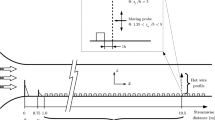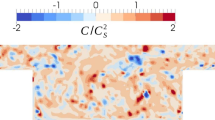Abstract
The influence of local surface heating and cooling on flow over urban-like roughness is investigated using large-eddy simulations. By adjusting the incoming or outgoing heat flux from the ground surface, various degrees of local thermal stratification, represented by a Richardson number \((Ri_\tau )\), were attained. Drag and heat transfer coefficients, turbulence structure, integral length scales, and the strength of quadrant events that contribute to momentum and heat fluxes were obtained and are compared with locally stable, neutral and unstable flows. With increasing \(Ri_\tau \), or equivalently as the flow characteristics change from local thermal instability to stability, a gradual decline in the drag and heat transfer coefficients is observed. These values are found to be fairly independent of the type of thermal boundary condition (constant heat flux or constant temperature) and domain size. The maps of anisotropy invariants showed that for the values of \(Ri_\tau \) considered, turbulence structures are almost the same in shape for neutral and unstable cases but differ slightly from those in the stable case. The degree of anisotropy is found to decrease as \(Ri_\tau \) increases from \(-2\) to 2.5. Compared to the neutral case, the integral length scales are shortened in the streamwise and vertical direction by ground cooling, but enhanced in the vertical direction with ground heating. Quadrant analysis showed that an increase in floor heating increases the strength of ejections above the canopy. However, the contributions of updrafts or downdrafts to the heat flux are found not to be significantly influenced by the type of local thermal stratification for the values of \(Ri_\tau \) considered. From the octant analysis, the transport mechanisms of momentum and heat above the canopy are found to be very similar in both locally unstable and stable flows.













Similar content being viewed by others
References
Allegrini J, Dorer V, Carmeliet J (2013) Wind tunnel measurements of buoyant flows in street canyons. Build Environ 59:315–326
Armenio V, Sarkar S (2002) An investigation of stably stratified turbulent channel flow using large-eddy simulation. J Fluid Mech 459:1–42
Boppana VBL, Xie ZT, Castro IP (2010) Large-eddy simulation of dispersion from surface sources in arrays of obstacles. Boundary-Layer Meteorol 135:433–454
Boppana VBL, Xie ZT, Castro IP (2013) Large-eddy simulation of heat transfer from a single cube mounted on a very rough wall. Boundary-Layer Meteorol 147:347–368
Britter RE, Hanna SR (2003) Flow and dispersion in urban areas. Annu Rev Fluid Mech 35:469–496
Busse A, Sandham ND (2012) Parametric forcing approach to rough-wall turbulent channel flow. J Fluid Mech 712:169–202
Cai X (2012) Effects of differential wall heating in street canyons on dispersion and ventilation characteristics of a passive scalar. Atmos Environ 51:268–277
Castro IP, Cheng H, Reynolds R (2006) Turbulence over urban-type roughness: deductions from wind-tunnel measurements. Boundary-Layer Meteorol 118:109–131
Cheng H, Castro IP (2002) Near wall flow over urban-like roughness. Boundary-Layer Meteorol 104:229–259
Cheng WC, Liu CH (2011) Effect of unstable thermal stratification on the atmospheric boundary layer above urban street canyons by large-eddy simulation. In: Proceeding of the 14th international conference on harmonisation within atmospheric dispersion modelling for regulatory purposes (HARMO 14), Kos, Greece, 2–6 October 2011
Christen A, van Gorsel E, Vogt R (2007) Coherent structures in urban roughness sublayer turbulence. Int J Climatol 27:1955–1968
Coceal O, Thomas TG, Castro IP, Belcher SE (2006) Mean flow and turbulence statistics over groups of urban-like cubical obstacles. Boundary-Layer Meteorol 121:491–519
Coceal O, Dobre A, Thomas TG, Belcher SE (2007) Structure of turbulent flow over regular arrays of cubical roughness. J Fluid Mech 589:375–409
Dong YH, Lu XY (2005) Direct numerical simulation of stably and unstably stratified turbulent open channel flows. Acta Mech 177:115–136
Dupont S, Patton EG (2012) Momentum and scalar transport within a vegetation canopy following atmospheric stability and seasonal canopy changes: the chats experiment. Atmos Chem Phys 12:5913–5935
Fishpool GM, Lardeau S, Leschziner MA (2009) Persistent non-homogeneous features in periodic channel-flow simulations. Flow Turbul Combust 83:323–342
Gao W, Shaw RH, Pawu KT (1989) Observation of organized structure in turbulent flow within and above a forest canopy. Boundary-Layer Meteorol 47:349–377
García-Villalba M, del Álamo J (2011) Turbulence modification by stable stratification in channel flow. Phys Fluids 23(045):104–122
Huizhi L, Bin L, Fengrong Z, Boyin Z, Jianguo S (2003) A laboratory model for the flow in urban street canyons induced by bottom heating. Adv Atmos Sci 20:554–564
Inagaki A, Castillo MCL, Yamashita Y, Kanda M, Takimoto H (2012) Large-eddy simulation of coherent flow structures within a cubical canopy. Boundary-Layer Meteorol 142:207–222
Jackson PS (1981) On the displacement height in the logarithmic velocity profile. J Fluid Mech 111:15–25
Jayatilleka CL (1969) The influence of prandtl number and surface rouhness on the resistance of the laminar sub-layer to momentum and heat transfer. Prog Heat Mass Transf 1:193–330
Kaimal JC, Finnigan JJ (1994) Atmospheric boundary layer flows: their structure and measurement. Oxford University Press, New York, 304 pp
Kanda M, Kanega M, Kawai T, Moriwaki R (2007) Roughness lengths for momentum and heat derived from outdoor urban scale models. J Appl Meteorol Climatol 46:1067–1079
Kim JJ, Baik JJ (1999) A numerical study of thermal effects on flow and pollutant dispersion in urban street canyons. J Appl Meteorol 38:1249–1261
Kovar-Panskus A, Moulinneuf L, Savory E, Abdelqari A, Sini JF, Rosant JM, Robins A, Toy N (2002) A wind tunnel investigation of the influence of solar-induced wall-heating on the flow regime within a simulated urban street canyon. Water Air Soil Pollut 2:555–571
Leonardi S, Castro IP (2010) Channel flow over large cube roughness: a direct numerical simulation study. J Fluid Mech 651:519–539
Li D, Bou-Zeid E (2011) Coherent structures and the dissimilarity of turbulent transport of momentum and scalars in the unstable atmospheric surface layer. Boundary-Layer Meteorol 140:243–262
Michioka T, Sato A, Sada K (2011) Wind-tunnel experiments for gas dispersion in an atmospheric boundary layer with large-scale turbulent motion. Boundary-Layer Meteorol 141:35–51
Park SB, Baik JJ, Raasch S, Letzel MO (2012) A large-eddy simulation study of thermal effects on turbulent flow and dispersion in and above a street canyon. J Appl Meteorol Climatol 51:829–841
Pascheke F, Barlow JF, Robins A (2008) Wind-tunnel modelling of dispersion from a scalar area source in urban-like roughness. Boundary-Layer Meteorol 126:103–124
Pope SB (2011) Turbulent flows. Cambridge University Press, Cambridge, 774 pp
Richards K, Schatzmann M, Leitl B (2006) Wind tunnel experiments modelling the thermal effects within the vicinity of a single block building with leeward wall heating. J Wind Eng Ind Aerodyn 94:621–636
Roth M, Inagaki A, Sugawara H, Kanda M (2013) Small-scale spatial variability of turbulent statistics, (co)spectra and turbulent kinetic energy measure over a regular array of cube roughness. Environ Fluid Mech. doi:10.1007/s10652-013-9322-3
Shih TH, Povinelli LA, Liu NS, Potapczuk MG, Lumley JL (1999) A generalized wall function. Tech. rep., National Aeronautics and Space Administration
STAR-CD (2007) CD-adapco’s CCM methodology, STAR-CD Version 4.04
Stull RB (2009) An Introduction to boundary-layer meteorology. Springer, New York, 674 pp
Uehara K, Murakami S, Oikawa S, Wakamatsu S (2000) Wind tunnel experiments on how thermal stratification affects flow in and above urban street canyons. Atmos Environ 34:1553–1562
Xie ZT, Hayden P, Wood CR (2013) Large-eddy simulation of approaching-flow stratification on dispersion over arrays of buildings. Atmos Environ 71:64–74
Acknowledgments
This project is funded by the Natural Environment Research Council, through its National Centre for Atmospheric Sciences, Grant No. R8/H12/38. All computations have been done using CD-adapco’s STAR-CD code on Iridis (University’s supercomputer) and HECToR (U.K’s supercomputer). We thank the CD-adapco’s staff Fred Mendonca for his continuous support. We thank the referees for their valuable comments.
Author information
Authors and Affiliations
Corresponding author
Rights and permissions
About this article
Cite this article
Boppana, V.B.L., Xie, ZT. & Castro, I.P. Thermal Stratification Effects on Flow Over a Generic Urban Canopy. Boundary-Layer Meteorol 153, 141–162 (2014). https://doi.org/10.1007/s10546-014-9935-1
Received:
Accepted:
Published:
Issue Date:
DOI: https://doi.org/10.1007/s10546-014-9935-1




